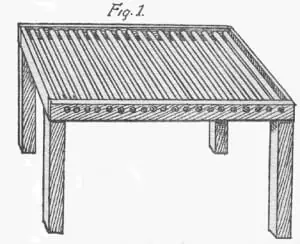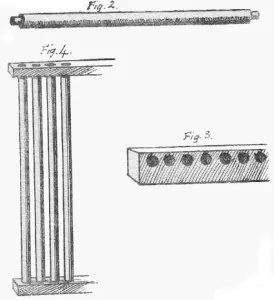Build a Wool Table
It is a good idea to use a wool table and class the wool even if you only have a few sheep. A buyer looking at a bale of wool which contains say 50 fleeces, and sees all sorts, coarse and fine, clean and dirty put together indiscriminately, will give you no more than the market value of the poorest fleece, which of course is your loss.

Having a wool table makes it easy to skirt (take off the dirty pieces) and roll up the fleece ready to put in the bale. To make a wool table as illustrated in Figure 1, any soft wood will do.
The rollers or spokes should be about 3 feet long and about ¾ of an inch in diameter. Pare each spoke down to ½ inch, leaving a equal shoulder on them as in Figure 2. Bore half inch holes to fit the end of the spokes as in Figure 3, and put together as in Figure 4. The timber is carefully planed and smoothed. To avoid catching strands of wool.
If a wooden table is too laborious, you could use steel pipe or quicker still, use half inch mesh or wire netting stretched over a table frame.
Skirting
When shearing remove the belly wool as soon as it is shorn, and keep separate if they are ewes and wethers mixed. Remove pizzle stain from the wether bellies. When the fleece is off, throw the fleece with the shorn side down. This allows the locks and second cuts to drop through under the table. Skirting is to take off all dirty edges of the fleece. Particularly sweaty sections around and under the legs. Be careful not to take off too much. The neck portion should come off and dirty parts along sides and breech. Keep your skirtings or pieces to be looked over again, and have all stains and dags removed. It is not advisable to make two classes of your pieces with a small flock. Having skirted your fleece, turn the sides into the middle and roll up.
Classing
In classing your fleece, if you have all Merino, don’t worry about any distinction, beyond keeping out any bad fleece. Such as very short stapled, or one badly stained in colour, or a very dirty one. It is a better approach to tear a bad one up and put it with the pieces.
On no account mix Merino and crossbred together, not even pieces or bellies.
In a crossbred flock there is more difficulty in classing than in Merino. As you will get one fleece of coarse, kempy, and the next might be any grade next to Merino.
It is just as much a mistake to make too many classes as none. The small flock owner will find it is quite sufficient to make a fine class and a coarse class in the crossbreds. The length of the staple is a consideration. If you come across a fine fleece with a long staple it is better to put it with the coarser class. That is of course, if there is a marked difference from your fine class in length.
Build a Wool Table – Baling

It is just as important to keep the wool from Merino and crossbred lambs separate, as it is in sheep. Put a sheet of some sort over your wool table to prevent the small wool pieces falling through. Pick up a lamb’s fleece with two boards. Each about 2 feet long and 6 or 8 inches broad. Take one in either hand and lift the wool onto the table.
Shake out and pick out any dirty parts. When you find that you don’t have sufficient of one lot or class to make a bale. In inferior classes, put different lots in the one bale. Put in your first lot, say the locks form under the table. Then place a piece of pack or bag on top of them, and put in stained pieces, and brand your bale as illustrated. That’s the end of build a wool table.
You can also view How to tell a sheep’s age and sheep shearing.


